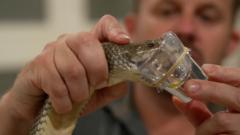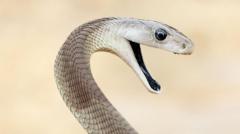In a small room at the Australian Reptile Park, a dedicated team works tirelessly to extract venom from some of the world’s most dangerous creatures. Emma Teni, affectionately known as "spider girl," spends her days milking Sydney funnel-web spiders — infamous for their lethal venom. Since the inception of the antivenom program in 1981, no fatalities from these spiders have occurred, thanks to the efforts of Emma and her colleagues who rely on community involvement to collect these arachnids.
The Life-Saving Secret of Australia’s Most Dangerous Creatures

The Life-Saving Secret of Australia’s Most Dangerous Creatures
Australia's venomous wildlife isn't just lethal; it plays a crucial role in saving lives through antivenom.
Amassing enough venom to produce antivenom requires cooperation from the public, and Emma urges safety over aggression: rather than kill the spiders, people should capture and deliver them for life-saving use. These extracts aren’t only limited to funnel-web spiders; snakes, too, are a vital part of antivenom production. While snake bites claim many lives worldwide, Australia's strategic antivenom management ensures that dangerous encounters result in minimal casualties.
Billy Collett, the park's operations manager, showcases the ongoing process of venom collection from snakes, emphasizing the importance of educating the public about responsible and safe interactions with these creatures. With a staggering number of antivenom vials produced annually and a network extending even to Papua New Guinea, the Australian antivenom program is both a marvel of science and a vital safety net for communities.
As the team continues their life-saving work, they demonstrate how understanding and coexisting with Australia's deadly wildlife can turn threats into life-saving resources.
Australia’s venomous creatures are more than just symbols of danger; they are essential to medical advancements that save lives every year.
In this vibrant ecosystem where wildlife encounters are common, fostering a sense of respect and responsibility towards these creatures can lead to a safer experience for all.
Australia’s venomous wildlife isn’t just lethal; it plays a crucial role in saving lives through antivenom.
In a small room at the Australian Reptile Park, a dedicated team works tirelessly to extract venom from some of the world’s most dangerous creatures. Emma Teni, affectionately known as "spider girl," spends her days milking Sydney funnel-web spiders — infamous for their lethal venom. Since the inception of the antivenom program in 1981, no fatalities from these spiders have occurred, thanks to the efforts of Emma and her colleagues who rely on community involvement to collect these arachnids.
Amassing enough venom to produce antivenom requires cooperation from the public, and Emma urges safety over aggression: rather than kill the spiders, people should capture and deliver them for life-saving use. These extracts aren’t only limited to funnel-web spiders; snakes, too, are a vital part of antivenom production. While snake bites claim many lives worldwide, Australia's strategic antivenom management ensures that dangerous encounters result in minimal casualties.
Billy Collett, the park's operations manager, showcases the ongoing process of venom collection from snakes, emphasizing the importance of educating the public about responsible and safe interactions with these creatures. With a staggering number of antivenom vials produced annually and a network extending even to Papua New Guinea, the Australian antivenom program is both a marvel of science and a vital safety net for communities.
As the team continues their life-saving work, they demonstrate how understanding and coexisting with Australia's deadly wildlife can turn threats into life-saving resources.
Australia’s venomous creatures are more than just symbols of danger; they are essential to medical advancements that save lives every year. In this vibrant ecosystem where wildlife encounters are common, fostering a sense of respect and responsibility towards these creatures can lead to a safer experience for all.
Billy Collett, the park's operations manager, showcases the ongoing process of venom collection from snakes, emphasizing the importance of educating the public about responsible and safe interactions with these creatures. With a staggering number of antivenom vials produced annually and a network extending even to Papua New Guinea, the Australian antivenom program is both a marvel of science and a vital safety net for communities.
As the team continues their life-saving work, they demonstrate how understanding and coexisting with Australia's deadly wildlife can turn threats into life-saving resources.
Australia’s venomous creatures are more than just symbols of danger; they are essential to medical advancements that save lives every year.
In this vibrant ecosystem where wildlife encounters are common, fostering a sense of respect and responsibility towards these creatures can lead to a safer experience for all.
Australia’s venomous wildlife isn’t just lethal; it plays a crucial role in saving lives through antivenom.
In a small room at the Australian Reptile Park, a dedicated team works tirelessly to extract venom from some of the world’s most dangerous creatures. Emma Teni, affectionately known as "spider girl," spends her days milking Sydney funnel-web spiders — infamous for their lethal venom. Since the inception of the antivenom program in 1981, no fatalities from these spiders have occurred, thanks to the efforts of Emma and her colleagues who rely on community involvement to collect these arachnids.
Amassing enough venom to produce antivenom requires cooperation from the public, and Emma urges safety over aggression: rather than kill the spiders, people should capture and deliver them for life-saving use. These extracts aren’t only limited to funnel-web spiders; snakes, too, are a vital part of antivenom production. While snake bites claim many lives worldwide, Australia's strategic antivenom management ensures that dangerous encounters result in minimal casualties.
Billy Collett, the park's operations manager, showcases the ongoing process of venom collection from snakes, emphasizing the importance of educating the public about responsible and safe interactions with these creatures. With a staggering number of antivenom vials produced annually and a network extending even to Papua New Guinea, the Australian antivenom program is both a marvel of science and a vital safety net for communities.
As the team continues their life-saving work, they demonstrate how understanding and coexisting with Australia's deadly wildlife can turn threats into life-saving resources.
Australia’s venomous creatures are more than just symbols of danger; they are essential to medical advancements that save lives every year. In this vibrant ecosystem where wildlife encounters are common, fostering a sense of respect and responsibility towards these creatures can lead to a safer experience for all.


















